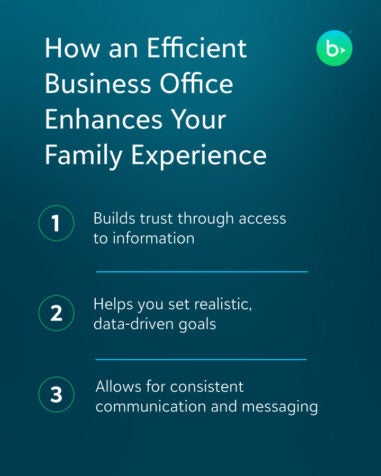How a Streamlined K–12 Business Office Improves Your Family Experience

Running a private K–12 school requires more than a strong academic program. It takes a business office that’s streamlined, transparent, and aligned with your school’s mission.
When your business office processes are efficient, you make life easier for families and staff alike. Integrated systems, accurate reporting, and clear communication create a seamless experience for everyone involved.
By simplifying your operations, you help families stay informed, reduce confusion, and build trust.
The Importance of Transparency in K–12 Private School Business Offices
Transparency is the foundation of trust, and when it comes to managing your school’s finances, it matters to your families more than you might think. A clear view into how funds are allocated—whether for classroom resources, facility upgrades, or extracurricular programs—gives your families confidence in the school’s ability to manage resources effectively.
With detailed reporting, your staff can share accurate updates on tuition rates, financial aid programs, or capital projects. When your families can see the priorities and fiscal decisions in black and white, they are less likely to feel left in the dark. Transparent processes also help avoid misunderstandings or disputes over charges, providing a smoother and more predictable experience.
Your families benefit when you prioritize accountability and open communication. Whether it’s an annual financial report or a regular update on fundraising progress, these efforts show them how their tuition dollars are making an impact—and why the school’s financial management is worth trusting.
Here are three ways an efficient business office can enhance the family experience at your school.

1. Builds Trust Through Access to Information
Trust starts with clarity, and that’s exactly what your business office provides when it operates with accurate reporting and integrated systems. Families want to understand what they’re paying for, how their financial aid applies, and what their total tuition costs are—and they don’t want to search across multiple platforms to find that information.
With an integrated payment portal, you give families a clear breakdown of tuition, fees, and optional charges, all in one place. Whether it’s summer school, extracurricular activities, or tuition discounts from state choice programs or financial aid, every charge displays transparently. Families can also select payment plans based on what works for them, whether it’s paying in full, by semester, or monthly.
Split-family scenarios are another area where you need efficient systems. Divorced parents or extended family members who share tuition costs can access individual views of their portion of the charges, eliminating confusion. Your team doesn’t have to manually divide fees, and every payee has an accurate and accessible portal tailored to their needs.
View-only access for staff ensures that your team is working from the same accurate data without the risk of unintended edits. A single source of truth minimizes errors and misunderstandings, allowing your office to focus on serving families instead of troubleshooting discrepancies. These tools don’t just make life easier—they demonstrate your school’s commitment to accountability and transparency, which builds credibility and confidence among families.
2. Helps You Set Realistic, Data-Driven Goals
When your systems are integrated, you have access to real-time data that reflects your school’s current financial and enrollment landscape. That means no more relying on outdated information to plan for the future. Integrated enrollment management systems feed contract details directly into your billing system, eliminating manual data entry. Families can update their own contact and billing information through the portal, further reducing the workload for your team.
Real-time tracking of net tuition revenue and delinquency figures empowers you to make informed decisions about your school’s financial strategy. Whether you’re assessing the need for assessing the need for a tuition reset or forecasting next year’s budget, drill-down reporting helps you identify trends and address gaps efficiently.
With integrations across your systems—such as connecting enrollment, tuition, donor management, and financial tracking tools—automated reconciliation, you create a unified view of your school’s financial health. This allows you to build strategies that are forward-looking and data-driven, aligning your financial goals with the needs of your families and your school’s overall mission.
3. Allows for Consistent Communication and Messaging
Clear and consistent communication is the basis of strong relationships with families, and an efficient business office ensures that the data informing your messaging aligns across departments. From financial aid notices to delinquency alerts, your communication is more effective when it’s centralized and integrated.
Families can receive payment reminders and billing updates through the same portal they use to check grades, schedules, and teacher messages. Instead of juggling multiple logins and platforms, families have one centralized place to stay informed about everything related to your school.
Your team can also use delinquency alerts as a proactive tool. If a family is struggling to pay, your office can reach out to offer support, whether it’s a new payment plan or mid-year financial aid adjustments. This personalized approach not only resolves issues but strengthens relationships with families by showing you care.
When all departments operate from the same data, you create a more unified message about your school’s priorities and financial management. Whether you’re preparing an annual report or showing families how tuition supports your mission, integrated systems ensure consistency and clarity every step of the way.
The Business Office’s Role in Enhancing the Family Experience
Your business office is at the heart of your school’s operations. By embracing transparency, integrating systems, and providing accurate reporting, you create a foundation for better family experiences. An efficient business office doesn’t just simplify processes—it allows your team to focus on supporting the school’s mission and serving your community. When your financial operations run smoothly, you build trust, reduce confusion, and empower families to engage fully with your school.
Want to learn more about how fund accounting software can help your school operate more efficiently and improve the family experience? Check out our white paper, Why K–12 Schools Need Fund Accounting Software.

